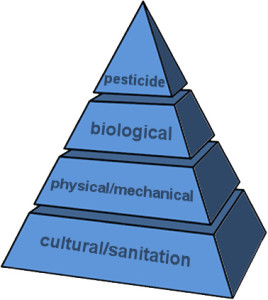
A well balanced IPM program will rely largely on good cultural and sanitation practices and rely least on pesticides.
If you want the safest, most effective form of pest control in your home, school or business, you want integrated pest management, or IPM. Born from the pesticide crisis following publication of books like Silent Spring and failures of many pesticides due to problems with resistance, IPM is considered the best management practice for pest control today.
But what is IPM? At its simplest, IPM is the use of multiple control tactics to control pests. IPM programs seek to rely on a blend of non-chemical, biological and chemical methods to control pests. When pesticides are used, they are used judiciously and only when the cost of not treating exceeds the environmental and economic cost of the pesticide.
IPM starts by confirming the identity of a pest, then using knowledge of pest’s biology to design the best, most effective and environmentally safe control strategy.
For years pest control consisted of routine applications of pesticides. Even today, the first question many of us ask when faced with a weed, or insect or plant disease problem is, “what do I spray?” But sprays or other chemical applications are not always the best approach. Sometimes changing the conditions that led to a pest problem is the most effective and environmentally safe approach.
An analogy
Imagine that you schedule a physical check-up with your doctor. When you walk into the doctor’s office you expect to be asked questions about your recent health. You also expect to have your temperature and blood pressure taken, and be examined by your doctor. You would expect her to ask you about possible allergies and check your records. Now suppose you walk into the doctor’s office have an aide glance at you, whip out a needle and say, “this is what you need. We give this to all our patients.” That’s similar to many pest control programs still in place today. Without a careful assessment of the pest problem first, and willingness (and knowledge) to use the best of all available tools, we risk being just like the very unprofessional physician’s aide.
How do I get started with IPM?
First of all, make sure you know what your pest problem is. If you have sick trees, is it a pathogen or insect? Could it be an environmental problem like drought or damage caused by construction? If it’s an ant, or a fly indoors, what kind of ant or fly is it? Knowing the precise pest can be critical for choosing the right control method.
If you lack the knowledge to make a good identification, or are unsure of the best control, contact a professional or an Extension resource for help. If you decide to hire a pest control company, or lawn care company, or arborist, ask them if they use an IPM approach. Ask questions about your problem and how they plan to address it. A company that uses IPM will be well-trained and certified, will be skilled at pest identification and will use multiple control strategies. Pesticides will be selected not only for their effectiveness, but also their safety.